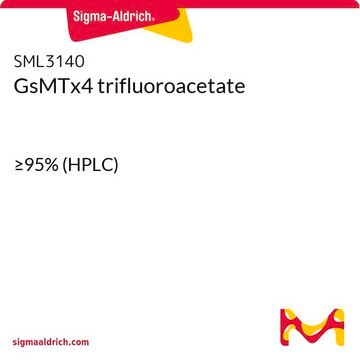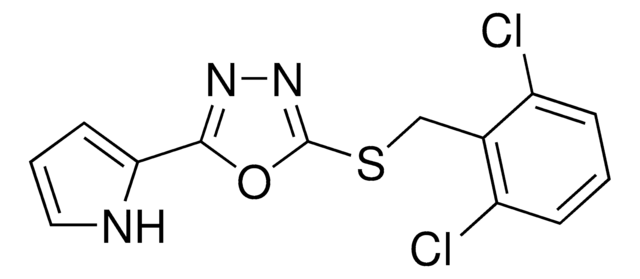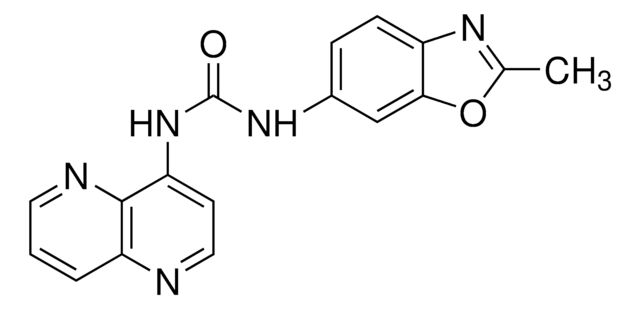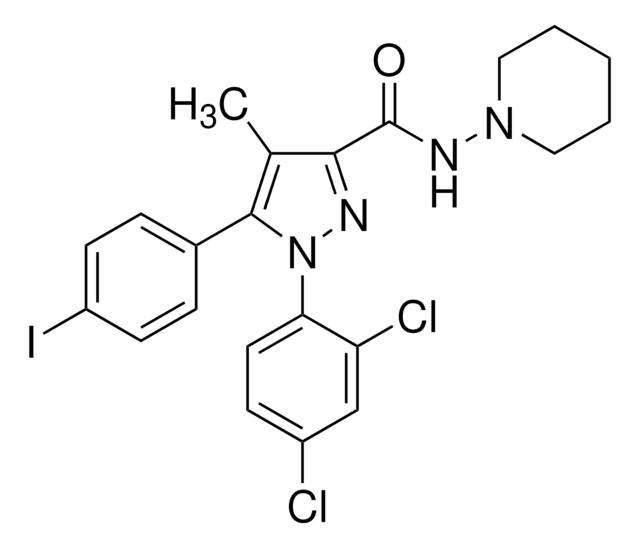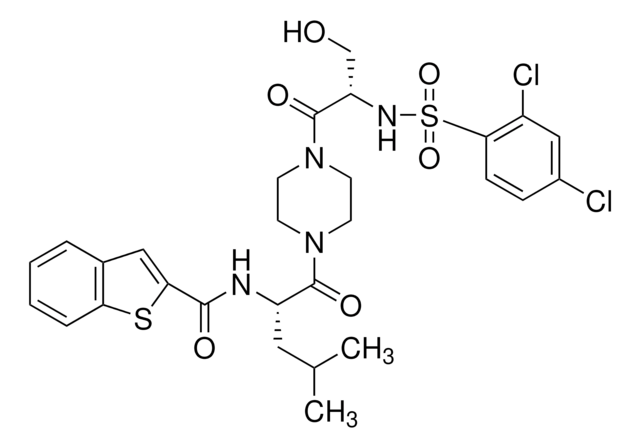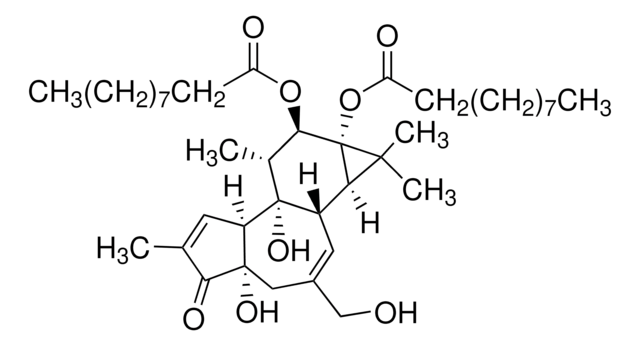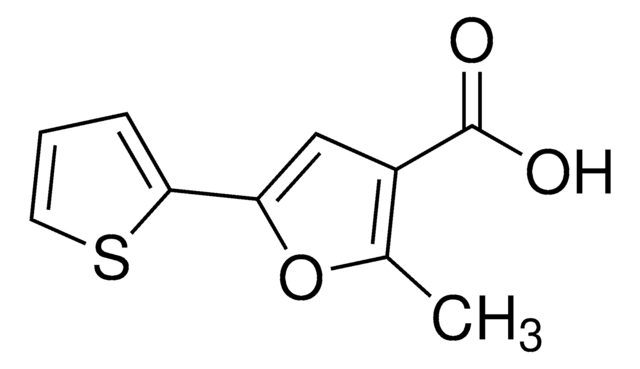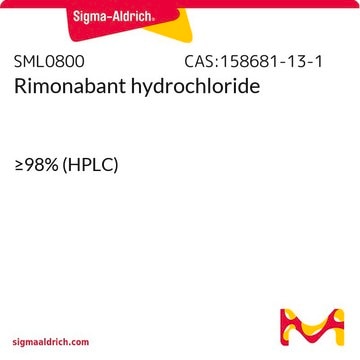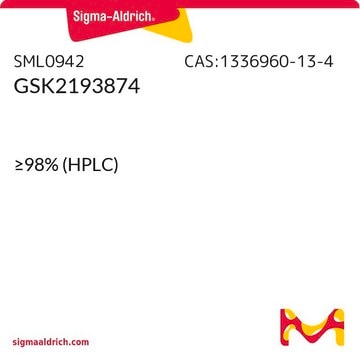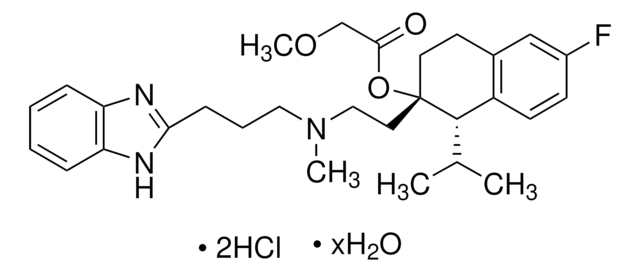SML1558
Yoda1
≥98% (HPLC), powder, Piezo1 agonist
Synonym(s):
2-[5-[[(2,6-Dichlorophenyl)methyl]thio]-1,3,4-thiadiazol-2-yl]-pyrazine
Sign Into View Organizational & Contract Pricing
All Photos(1)
About This Item
Empirical Formula (Hill Notation):
C13H8Cl2N4S2
CAS Number:
Molecular Weight:
355.27
UNSPSC Code:
12352200
NACRES:
NA.77
Recommended Products
product name
Yoda1, ≥98% (HPLC)
Quality Level
assay
≥98% (HPLC)
form
powder
color
white to beige
solubility
DMSO: 15 mg/mL, clear
storage temp.
2-8°C
General description
Yoda1 is a novel synthetic small molecule developed to study the kinetics, regulation and function of the cation channel Piezo-type mechanosensitive ion channel component 1 (Piezo1).
Application
Yoda1 has been used to investigate its effect on heterotrimeric Piezo1 channels.
Biochem/physiol Actions
Yoda1 is a specific activator of mouse and human cation channel Piezo1, a mechanosensitive channel that mediates Ca2+ influx on mechanical activation and has been linked to a role in blood vessel development. Yoda1 stabilizes the Piezo1 open channel. In red blood cells, this was followed by downstream activation of the KCa3.1 Gardos channel with resultant calcium influx and potassium and water efflux, causing shrinkage of the cells. Yoda1 is the first Piezo1 agonist, giving the first evidence of non-mechanical activation of a Piezo channel.
signalword
Warning
hcodes
Hazard Classifications
Acute Tox. 4 Oral
wgk_germany
WGK 3
flash_point_f
Not applicable
flash_point_c
Not applicable
Certificates of Analysis (COA)
Search for Certificates of Analysis (COA) by entering the products Lot/Batch Number. Lot and Batch Numbers can be found on a product’s label following the words ‘Lot’ or ‘Batch’.
Already Own This Product?
Find documentation for the products that you have recently purchased in the Document Library.
Customers Also Viewed
Chemical gating of the mechanosensitive Piezo1 channel by asymmetric binding of its agonist Yoda1.
Lacroix JJ, et al.
bioRxiv, 169516-169516 (2017)
Lei Liu et al.
Frontiers in pharmacology, 12, 606245-606245 (2021-04-13)
XueShuanTong (XST) comprising therapeutically active ginsenosides, a lyophilized extract of Panax notoginseng roots, is extensively used in traditional Chinese medicine to treat ischemic heart and cerebrovascular diseases. Our recent study shows that treatment with XST inhibits shear-induced thrombosis formation but
Jerome J Lacroix et al.
Nature communications, 9(1), 2029-2029 (2018-05-26)
Piezo proteins are transmembrane ion channels which transduce many forms of mechanical stimuli into electrochemical signals. Their pore, formed by the assembly of three identical subunits, opens by an unknown mechanism. Here, to probe this mechanism, we investigate the interaction
Immacolata Andolfo et al.
American journal of hematology, 95(2), 188-197 (2019-11-19)
Dehydrated hereditary stomatocytosis (DHS), or xerocytosis, is an autosomal dominant hemolytic anemia. Most patients with DHS carry mutations in the PIEZO1 gene encoding a mechanosensitive cation channel. We here demonstrate that patients with DHS have low levels of hepcidin and
Ruhma Syeda et al.
eLife, 4 (2015-05-23)
Piezo ion channels are activated by various types of mechanical stimuli and function as biological pressure sensors in both vertebrates and invertebrates. To date, mechanical stimuli are the only means to activate Piezo ion channels and whether other modes of
Our team of scientists has experience in all areas of research including Life Science, Material Science, Chemical Synthesis, Chromatography, Analytical and many others.
Contact Technical Service